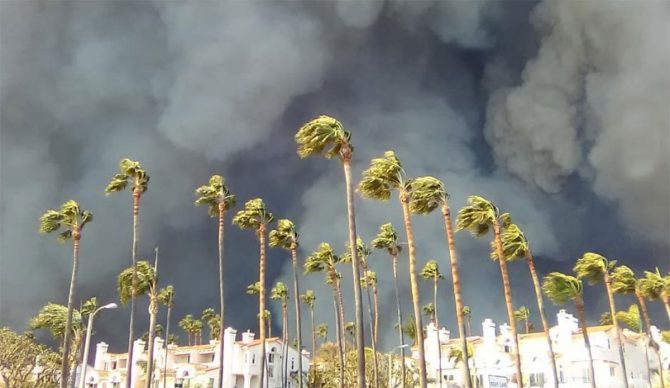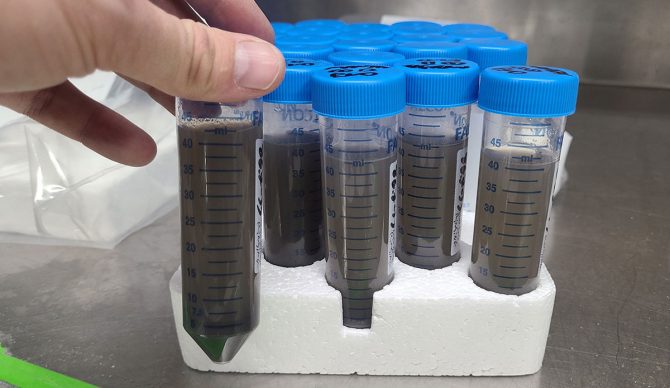
Smoke from the 2018 Woolsey Fire billows towards the sea. Photo: Haro
The wildfires that devastated parts of Southern California in January aren’t just harmful to those of us who walk on land. The falling ash that blows over the ocean could have disastrous effects on sea life, too.
According to UC San Diego’s Scripps Institution of Oceanography and NOAA Fisheries’ Southwest Fisheries Science Center, billowing smoke from the Palisades, Eaton, and other fires has deposited ash and debris on the ocean’s surface as much as 100 miles from the coast.
The crew aboard a NOAA research vessel called the Reuben Lasker was gathering water samples when the fires began. Over the next few days, they collected samples of the ash piling up on the deck of the ship, as well as in the sea.
“We’re positioning ourselves to answer the question, ‘What does this mean for West Coast fisheries and the food web that we all depend on?’” said Nicolas Concha-Saiz, NOAA Fisheries’ chief scientist.
Of course, ash from wildfires hits the ocean often, and has done so since time immemorial. In modern times, though, it’s not just ash from trees, grass, and other vegetation. It’s ash from houses and plastic and cleaning supplies and all manner of toxic products that we use on a daily basis to make our lives more comfortable. Those things are decidedly bad, not just for us, but for most life forms.
“These fires are not only consuming vegetation but also massive amounts of urban infrastructure,” said project leader Julie Dinasquet of Scripps Oceanography. “This introduces a novel ‘urban ash’ component to the wildfire source, filled with exceptionally toxic materials such as heavy metals like lead, arsenic, as well as asbestos fibers, polycyclic aromatic hydrocarbons (PAHs) and microplastics. These fires pose a potential significant threat to both humans and ecosystems through the introduction of a large amount of toxic material in the system.”
Aside from the fact that we really ought to care about the animals we share the planet with for caring’s sake, scientists are also studying how much the ash will affect things like the commercial fishing industry.

Ash collected from a “Manta” plankton net, which samples the top six inches of the ocean. Initially the ash floats on the surface, but once mixed with the water, it sinks rapidly. Photo: Rasmus Swalethorp//UCSD
“Scientists aboard R/V Reuben Lasker are collecting water samples to assess the spread of the ash,” researchers at UC San Diego wrote. “They will also monitor for toxics that could affect one of the country’s most productive marine ecosystems that supports important commercial and recreational fisheries.”
The coast of California is a well-researched area, with plenty of historical data to compare, so it’s about as good a place as you can get for research like this.
“We have painstakingly saved archives of samples with treasure troves of information,” said Noelle Bowlin, NOAA Fisheries’ CalCOFI Director. “Any time there is a question, we can turn to the samples and see what changed.”
Even 100 miles out to sea, the researchers were stunned at how destructive the fires were. “Seeing it snowing, but knowing it wasn’t snow but ash was really eerie,” said Scripps Oceanography biological oceanographer Rasmus Swalethorp. “It seemed apocalyptic. I can only imagine how it must have been on land.”
The scientists are hoping that their data will help better understand the impact of events like the Palisades and Eaton fires, and how it might affect the marine ecosystem. It’s likely that there will be more and bigger fires in the future, so learning as much as we can about their impacts is extraordinarily important.
“What is most surprising to us is the size of the debris observed,” Dinasquet continued. “There seems to be pieces of charred material up to five centimeters (two inches) long. We are sampling surface water but also deeper layers under 100 meters (330 feet) deep to see if we can observe sinking ash particles and how this material has changed and potentially leached toxics and other molecules as it sinks and how this will impact the ecosystem.”

